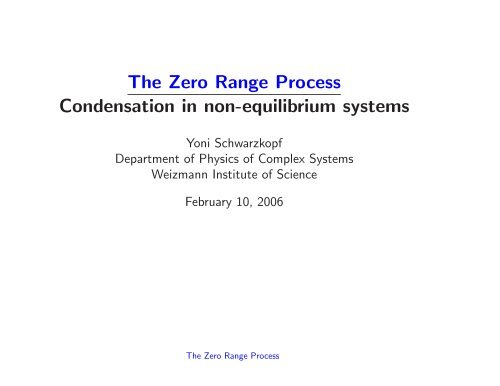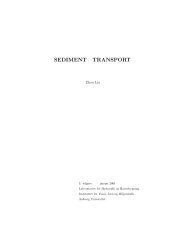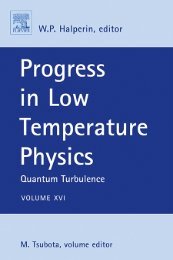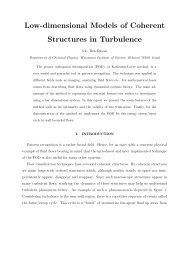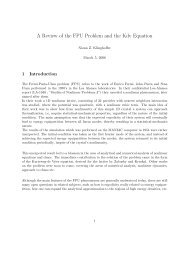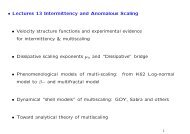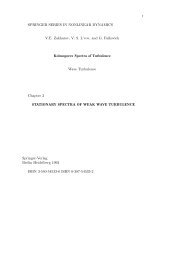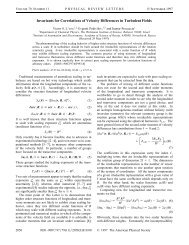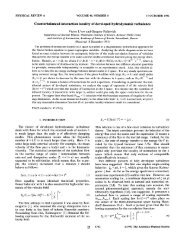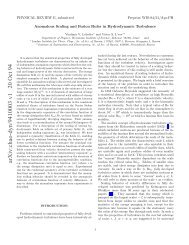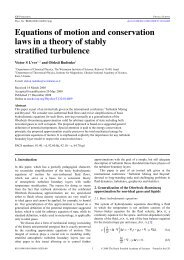The Zero Range Process Condensation in non-equilibrium systems
The Zero Range Process Condensation in non-equilibrium systems
The Zero Range Process Condensation in non-equilibrium systems
You also want an ePaper? Increase the reach of your titles
YUMPU automatically turns print PDFs into web optimized ePapers that Google loves.
<strong>The</strong> <strong>Zero</strong> <strong>Range</strong> <strong>Process</strong><br />
<strong>Condensation</strong> <strong>in</strong> <strong>non</strong>-<strong>equilibrium</strong> <strong>systems</strong><br />
Yoni Schwarzkopf<br />
Department of Physics of Complex Systems<br />
Weizmann Institute of Science<br />
February 10, 2006<br />
<strong>The</strong> <strong>Zero</strong> <strong>Range</strong> <strong>Process</strong>
Yoni Schwarzkopf February 10, 2006<br />
Introduction<br />
• Phase transitions <strong>in</strong> <strong>equilibrium</strong> <strong>systems</strong> are well studied:<br />
BEC (Bose-E<strong>in</strong>ste<strong>in</strong> Condensates)<br />
Liquid Gas Transitions<br />
.<br />
• 1d <strong>equilibrium</strong> <strong>systems</strong> have no phase transitions (Only for strong long range<br />
<strong>in</strong>teractions)<br />
<strong>The</strong> <strong>Zero</strong> <strong>Range</strong> <strong>Process</strong> 1
Yoni Schwarzkopf February 10, 2006<br />
Introduction (2)<br />
• Non <strong>equilibrium</strong> <strong>systems</strong> offer rich phenomena even <strong>in</strong> 1d:<br />
TAESP totally asymmetrical exclusion process<br />
• Need a simple coarse gra<strong>in</strong>ed model to offer universal <strong>in</strong>sights<br />
TAESP → <strong>Zero</strong> <strong>Range</strong> <strong>Process</strong><br />
<strong>The</strong> <strong>Zero</strong> <strong>Range</strong> <strong>Process</strong> 2
Yoni Schwarzkopf February 10, 2006<br />
Non-Equilibrium: General properties<br />
• Let C be a configuration of a system<br />
• Def<strong>in</strong>e P(C,t): the probability to be <strong>in</strong> a configuration of a system at time t.<br />
• W(C → C ′ ): transition rate between configurations<br />
• Master Equation 1 :<br />
∂P(C,t)<br />
∂t<br />
= <br />
W(C ′ → C)P(C ′ , t) − <br />
W(C → C ′ )P(C,t) (1)<br />
C ′<br />
1 Phase Transitions <strong>in</strong> Non<strong>equilibrium</strong> Systems. D. Mukamel (2000)<br />
<strong>The</strong> <strong>Zero</strong> <strong>Range</strong> <strong>Process</strong> 3<br />
C
Yoni Schwarzkopf February 10, 2006<br />
Non-Equilibrium: General properties (2)<br />
• In thermal <strong>equilibrium</strong> we have hamiltonian H<br />
• P(C) ∼ e −E(C)/K BT<br />
• Equilibrium ⇒ detailed balance<br />
W(C ′ → C)P(C ′ ,t) = W(C → C ′ )P(C,t) ∀C, C ′<br />
• Non-Equilibrium ⇒ NO detailed balance<br />
<strong>The</strong> <strong>Zero</strong> <strong>Range</strong> <strong>Process</strong> 4<br />
(2)
Yoni Schwarzkopf February 10, 2006<br />
<strong>Zero</strong> <strong>Range</strong> <strong>Process</strong> (ZRP)<br />
<strong>The</strong> ZRP is a <strong>non</strong>-l<strong>in</strong>ear stochastic model of <strong>in</strong>teract<strong>in</strong>g particles on a Lattice,<br />
hopp<strong>in</strong>g from site to site with a rate that depends solely on the occupation of the<br />
departure site.<br />
<strong>The</strong> <strong>Zero</strong> <strong>Range</strong> <strong>Process</strong> 5
Yoni Schwarzkopf February 10, 2006<br />
<strong>Zero</strong> <strong>Range</strong> <strong>Process</strong> (ZRP) (2)<br />
• <strong>The</strong> hopp<strong>in</strong>g rate from a lattice site ℓ with nℓ particles occupy<strong>in</strong>g it is denoted<br />
as uℓ(nℓ).<br />
<strong>The</strong> <strong>Zero</strong> <strong>Range</strong> <strong>Process</strong> 6
Yoni Schwarzkopf February 10, 2006<br />
<strong>Zero</strong> <strong>Range</strong> <strong>Process</strong> (ZRP) (3)<br />
• Homogenous case - u(nℓ) <strong>in</strong>dependent of position .<br />
• R<strong>in</strong>g Topology: 1D lattice with periodic boundaries of length L and N particles.<br />
<strong>The</strong> <strong>Zero</strong> <strong>Range</strong> <strong>Process</strong> 7
Yoni Schwarzkopf February 10, 2006<br />
<strong>Zero</strong> <strong>Range</strong> <strong>Process</strong> (ZRP) (4)<br />
• A configuration of the lattice is def<strong>in</strong>ed by the occupation of each site<br />
C ≡ {n1, n2, ...,nL}<br />
• Def<strong>in</strong>e the probability to f<strong>in</strong>d the lattice <strong>in</strong> configuration C at time t<br />
P(C,t) ≡ P(n1,n2,...,nL,t)<br />
<strong>The</strong> <strong>Zero</strong> <strong>Range</strong> <strong>Process</strong> 8
Yoni Schwarzkopf February 10, 2006<br />
<strong>Zero</strong> <strong>Range</strong> <strong>Process</strong> (5)<br />
• <strong>The</strong> master equation<br />
∂P({nℓ},t)<br />
∂t<br />
=<br />
L<br />
[u(nℓ−1)P(...,nℓ−1 + 1,nℓ − 1,...) − u(nℓ)P({nℓ})]Θ(nℓ)<br />
ℓ=1<br />
• exam<strong>in</strong>e steady state configurations<br />
∂P({nℓ},t)<br />
∂t<br />
<strong>The</strong> <strong>Zero</strong> <strong>Range</strong> <strong>Process</strong> 9<br />
= 0
Yoni Schwarzkopf February 10, 2006<br />
Steady State <strong>in</strong> the Ca<strong>non</strong>ical Ensemble<br />
• In the ca<strong>non</strong>ical ensemble the probability distribution can be written us<strong>in</strong>g<br />
steady state s<strong>in</strong>gle site weights-f<br />
P({nℓ}) = Z −1<br />
L,N<br />
L<br />
f(nℓ)δ(<br />
ℓ=1<br />
L<br />
nℓ = N) (3)<br />
ℓ=1<br />
• <strong>The</strong> ca<strong>non</strong>ical partition function is def<strong>in</strong>ed as follows<br />
ZL,N ≡ <br />
{n ℓ}<br />
L<br />
f(nℓ)δ(<br />
ℓ=1<br />
L<br />
nℓ = N) (4)<br />
<strong>The</strong> <strong>Zero</strong> <strong>Range</strong> <strong>Process</strong> 10<br />
ℓ=1
Yoni Schwarzkopf February 10, 2006<br />
Steady State <strong>in</strong> the Ca<strong>non</strong>ical Ensemble (2)<br />
• From the master equation<br />
f(n) =<br />
• <strong>The</strong> probability factorizes as follows<br />
P({nℓ}) =<br />
L<br />
m=1<br />
1<br />
u(m)<br />
(5)<br />
L<br />
p(nℓ) (6)<br />
• We will ma<strong>in</strong>ly be <strong>in</strong>terested <strong>in</strong> the s<strong>in</strong>gle site distribution function<br />
ℓ=1<br />
p(n) = f(n) ZL−1,N−n<br />
ZL,N<br />
<strong>The</strong> <strong>Zero</strong> <strong>Range</strong> <strong>Process</strong> 11<br />
(7)
Yoni Schwarzkopf February 10, 2006<br />
Grand Ca<strong>non</strong>ical Ensemble<br />
• <strong>The</strong> grand ca<strong>non</strong>ical partition function is def<strong>in</strong>ed as follows<br />
with F(λ) and f(m) def<strong>in</strong>ed as<br />
ZL(λ) = [F(λ)] L<br />
F(λ) =<br />
f(m) =<br />
∞<br />
m=0<br />
λ m f(m)<br />
m<br />
u(i) −1<br />
<strong>The</strong> <strong>Zero</strong> <strong>Range</strong> <strong>Process</strong> 12<br />
i=1<br />
(8)
Yoni Schwarzkopf February 10, 2006<br />
Grand Ca<strong>non</strong>ical Ensemble (2)<br />
• <strong>The</strong> fugacity λ corresponds to the steady state current < u(n) >= λ and is<br />
determ<strong>in</strong>ed through the density<br />
ρ = λ F ′ (λ)<br />
F(λ)<br />
<strong>The</strong> <strong>Zero</strong> <strong>Range</strong> <strong>Process</strong> 13<br />
(9)
Yoni Schwarzkopf February 10, 2006<br />
Grand Ca<strong>non</strong>ical Ensemble (3)<br />
•<strong>The</strong> s<strong>in</strong>gle site probability<br />
p(n) = λ n f(n) ZL−1(λ)<br />
ZL(λ)<br />
plugg<strong>in</strong>g <strong>in</strong> the def<strong>in</strong>ition of ZL yields<br />
p(n) = λn f(n)<br />
F(λ)<br />
(10)<br />
<strong>The</strong> <strong>Zero</strong> <strong>Range</strong> <strong>Process</strong> 14
Yoni Schwarzkopf February 10, 2006<br />
TASEP ⇒ ZRP<br />
a)<br />
b)<br />
Site:<br />
Particle:<br />
u(3)<br />
u(1)<br />
1 2 3 4<br />
u(2)<br />
u(3) u(1)<br />
u(2)<br />
1 2 3 4<br />
• In the TASEP hopp<strong>in</strong>g rates depend on <strong>in</strong>ter-particle distance<br />
5<br />
• Phase separation <strong>in</strong> the driven model (TASEP) corresponds to a macroscopic<br />
occupation <strong>in</strong> the ZRP model.<br />
2 Non<strong>equilibrium</strong> Statistical Mechanics of the <strong>Zero</strong>-<strong>Range</strong> <strong>Process</strong> and Related Models. Evans et al (2005).<br />
<strong>The</strong> <strong>Zero</strong> <strong>Range</strong> <strong>Process</strong> 15<br />
5<br />
2
Yoni Schwarzkopf February 10, 2006<br />
<strong>Condensation</strong> <strong>in</strong> the ZRP<br />
• <strong>The</strong> density (given <strong>in</strong> eq. 9) is clearly an <strong>in</strong>creas<strong>in</strong>g function of the fugacity z.<br />
ρ = z F ′ (z)<br />
F(z) =<br />
∞<br />
m=0 m zm f(m)<br />
∞<br />
m=0 zm f(m)<br />
• <strong>The</strong> maximum density is given by tak<strong>in</strong>g z → 1<br />
ρmax = F ′ (1)<br />
F(1) =<br />
∞<br />
m=0 mf(m)<br />
∞<br />
m=0 f(m)<br />
(11)<br />
(12)<br />
<strong>The</strong> <strong>Zero</strong> <strong>Range</strong> <strong>Process</strong> 16
Yoni Schwarzkopf February 10, 2006<br />
<strong>Condensation</strong> <strong>in</strong> the ZRP (2)<br />
• A system with a f<strong>in</strong>ite maximum density (critical density) ρc has three phases:<br />
1. ρ < ρc low density phase:<br />
A fluid obey<strong>in</strong>g the steady state distribution.<br />
2. ρ = ρc critical phase:<br />
A critical fluid with diverg<strong>in</strong>g correlation lengths .<br />
3. ρ > ρc condensed phase:<br />
A condensate <strong>in</strong> coexistence with the critical fluid.<br />
<strong>The</strong> <strong>Zero</strong> <strong>Range</strong> <strong>Process</strong> 17
Yoni Schwarzkopf February 10, 2006<br />
Analytically solvable case<br />
• TASEP: the particle current out of a doma<strong>in</strong> of length n decays as 3<br />
• Consider ZRP with hopp<strong>in</strong>g rate<br />
j(n) ∼ β(1 + b/n)<br />
u(n) = 1 + b/n (13)<br />
• Interested <strong>in</strong> condensation ⇒ <strong>in</strong>vestigate large n behavior<br />
3 Novel phase-separation transition <strong>in</strong> one-dimensianal driven models.<br />
Y.Kafri, E.Lev<strong>in</strong>e, D.mukamel, G.M.Schutz and R.D.Willmann. (2002)<br />
<strong>The</strong> <strong>Zero</strong> <strong>Range</strong> <strong>Process</strong> 18
Yoni Schwarzkopf February 10, 2006<br />
Analytically solvable case (2)<br />
• <strong>The</strong> steady state probability can be calculated numerically us<strong>in</strong>g a recursion<br />
relation for the partition function<br />
ZL,N =<br />
N<br />
n=0<br />
• <strong>The</strong> s<strong>in</strong>gle site probability distribution is<br />
f(n)ZL−1,N−n<br />
p(n) = f(n) ZL−1,N−n<br />
ZL,N<br />
(14)<br />
(15)<br />
<strong>The</strong> <strong>Zero</strong> <strong>Range</strong> <strong>Process</strong> 19
Yoni Schwarzkopf February 10, 2006<br />
Analytically solvable case (3)<br />
ln p(n)<br />
0.001<br />
1e-06<br />
1e-09<br />
1e-12<br />
1 10 100 1000 10000<br />
ln n<br />
Figure 1: Probability distribution calculated us<strong>in</strong>g the recursion relation. For<br />
L = 1000, b = 5 and ◦, ⋄ for ρ = 1/4, 4 respectively<br />
4<br />
4 Non<strong>equilibrium</strong> Statistical Mechanics of the <strong>Zero</strong>-<strong>Range</strong> <strong>Process</strong> and Related Models. Evans et al (2005).<br />
<strong>The</strong> <strong>Zero</strong> <strong>Range</strong> <strong>Process</strong> 20
Yoni Schwarzkopf February 10, 2006<br />
Analytically solvable case (4)<br />
• large n analysis:<br />
f(n) =<br />
ln (f(n)) = −<br />
≈ −<br />
n<br />
m=1<br />
the s<strong>in</strong>gle site weight is approximately<br />
[1 + b/m] −1<br />
n<br />
m=1<br />
n<br />
m=1<br />
ln (1 + b/m)<br />
b<br />
m<br />
f(n) ≈ n −b<br />
≈ −b ln(n)<br />
<strong>The</strong> <strong>Zero</strong> <strong>Range</strong> <strong>Process</strong> 21
Yoni Schwarzkopf February 10, 2006<br />
Analytically solvable case (5)<br />
• <strong>The</strong> large n probability<br />
• <strong>The</strong> density is given by<br />
ρ =<br />
p(n) ≈ λn<br />
n bp(0)<br />
N<br />
np(n) ≈<br />
n=1<br />
• <strong>The</strong> maximum density (λ → 1) behaves as<br />
ρmax ∼<br />
N<br />
n=1<br />
N<br />
n=1<br />
λ n<br />
n b−1p(0)<br />
1<br />
n b−1<br />
(16)<br />
(17)<br />
<strong>The</strong> <strong>Zero</strong> <strong>Range</strong> <strong>Process</strong> 22
Yoni Schwarzkopf February 10, 2006<br />
Analytically solvable case (6)<br />
• <strong>The</strong> condensation criterion (<strong>in</strong> the L → ∞ thermodynamic limit)<br />
• <strong>The</strong> critical density is given by 5<br />
b ≤ 2 ρmax → ∞<br />
b > 2 ρmax → ρc<br />
ρc = 1<br />
b − 2<br />
5 Non<strong>equilibrium</strong> Statistical Mechanics of the <strong>Zero</strong>-<strong>Range</strong> <strong>Process</strong> and Related Models. Evans et al (2005).<br />
(18)<br />
<strong>The</strong> <strong>Zero</strong> <strong>Range</strong> <strong>Process</strong> 23
Yoni Schwarzkopf February 10, 2006<br />
Analytically solvable case (7)<br />
For b > 2 the system has three phases<br />
1. low density phase:<br />
p(n) ∼ 1<br />
n<br />
where the correlation length ξ is def<strong>in</strong>ed as<br />
b exp−n/ξ<br />
ξ = 1<br />
|ln(λ)|<br />
(19)<br />
(20)<br />
For b < 2 one can easily see that ρ ≡< n > diverges hence no condensation<br />
will appear.<br />
<strong>The</strong> <strong>Zero</strong> <strong>Range</strong> <strong>Process</strong> 24
Yoni Schwarzkopf February 10, 2006<br />
Analytically solvable case (8)<br />
<br />
<br />
<br />
<br />
<br />
<br />
<br />
<br />
<br />
<br />
Figure 2: Probability distribution for L = 1000, b = 5 and ρ = 0.25.<br />
<strong>The</strong> <strong>Zero</strong> <strong>Range</strong> <strong>Process</strong> 25
Yoni Schwarzkopf February 10, 2006<br />
Analytically solvable case (9)<br />
<br />
<br />
<br />
<br />
<br />
<br />
<br />
<br />
<br />
<br />
<br />
<br />
<br />
Figure 3: Lattice occupation for L = 1000, b = 5 and ρ = 0.25.<br />
<strong>The</strong> <strong>Zero</strong> <strong>Range</strong> <strong>Process</strong> 26
Yoni Schwarzkopf February 10, 2006<br />
Analytically solvable case (10)<br />
2 critical phase:<br />
p(n) ∼ 1<br />
nb (21)<br />
S<strong>in</strong>ce the correlation length ξ diverges for λ → ∞ the critical fluid obeys a<br />
power distribution.<br />
Such a power distribution is called a scale free distribution<br />
<strong>The</strong> <strong>Zero</strong> <strong>Range</strong> <strong>Process</strong> 27
Yoni Schwarzkopf February 10, 2006<br />
Analytically solvable case (11)<br />
<br />
<br />
<br />
<br />
<br />
<br />
<br />
<br />
<br />
Figure 4: Probability distribution for L = 1000, b = 5 and ρ = ρc = 1/3.<br />
<strong>The</strong> <strong>Zero</strong> <strong>Range</strong> <strong>Process</strong> 28
Yoni Schwarzkopf February 10, 2006<br />
Analytically solvable case (12)<br />
<br />
<br />
<br />
<br />
<br />
<br />
<br />
<br />
<br />
<br />
<br />
<br />
<br />
<br />
Figure 5: Lattice occupation for L = 1000, b = 5 and ρ = ρc = 1/3.<br />
<strong>The</strong> <strong>Zero</strong> <strong>Range</strong> <strong>Process</strong> 29
Yoni Schwarzkopf February 10, 2006<br />
Analytically solvable case (13)<br />
3 condensed phase:<br />
p(n) ∼ 1<br />
nb (22)<br />
A scale free distribution with a s<strong>in</strong>gle peak <strong>in</strong> the distribution centered<br />
around n = L(ρ − ρc) correspond<strong>in</strong>g to a s<strong>in</strong>gle condensate <strong>in</strong> the L → ∞<br />
thermodynamic limit.<br />
<strong>The</strong> <strong>Zero</strong> <strong>Range</strong> <strong>Process</strong> 30
Yoni Schwarzkopf February 10, 2006<br />
Analytically solvable case (14)<br />
<br />
<br />
<br />
<br />
<br />
<br />
<br />
<br />
<br />
Figure 6: Probability distribution for L = 1000 , b = 5 and ρ = 2/3. <strong>The</strong><br />
condensate is expected to be centered at ∆ = L(ρ − ρc) = 333.<br />
<strong>The</strong> <strong>Zero</strong> <strong>Range</strong> <strong>Process</strong> 31
Yoni Schwarzkopf February 10, 2006<br />
Analytically solvable case (15)<br />
<br />
<br />
<br />
<br />
<br />
<br />
<br />
<br />
<br />
<br />
Figure 7: Lattice occupation for L = 1000, b = 5 and ρ = 2/3. <strong>The</strong> condensate<br />
is expected to be centered at ∆ = L(ρ − ρc) = 333.<br />
<strong>The</strong> <strong>Zero</strong> <strong>Range</strong> <strong>Process</strong> 32
Yoni Schwarzkopf February 10, 2006<br />
Analytically solvable case (16)<br />
<br />
<br />
<br />
<br />
<br />
<br />
<br />
<br />
<br />
<br />
<br />
<br />
<br />
<br />
Figure 8: <strong>The</strong> effect of the probability distribution for L = 1000 , b = 5 for<br />
different densities .<br />
<strong>The</strong> <strong>Zero</strong> <strong>Range</strong> <strong>Process</strong> 33
Yoni Schwarzkopf February 10, 2006<br />
Analytically solvable case (17)<br />
<br />
<br />
<br />
<br />
<br />
<br />
<br />
<br />
<br />
<br />
<br />
<br />
<br />
Figure 9: <strong>The</strong> effect of the probability distribution for L = 1000, b = 2.6 for<br />
different densities .<br />
<strong>The</strong> <strong>Zero</strong> <strong>Range</strong> <strong>Process</strong> 34
Yoni Schwarzkopf February 10, 2006<br />
Dynamics Of <strong>The</strong> Condensate<br />
• We have studied the steady state distribution for these processes<br />
<br />
<br />
<br />
<br />
<br />
<br />
<br />
<br />
<br />
<br />
<br />
Figure 10: <strong>The</strong> probability distribution for L = 1000, b = 2.6 and ρ = 4.<br />
<strong>The</strong> <strong>Zero</strong> <strong>Range</strong> <strong>Process</strong> 35
Yoni Schwarzkopf February 10, 2006<br />
Dynamics Of <strong>The</strong> Condensate (2)<br />
• <strong>The</strong>se states are not static but dynamic<br />
<br />
<br />
<br />
<br />
<br />
<br />
<br />
<br />
<br />
<br />
<br />
• Investigate the dynamical behavior of the condensate<br />
<strong>The</strong> <strong>Zero</strong> <strong>Range</strong> <strong>Process</strong> 36
Yoni Schwarzkopf February 10, 2006<br />
Dynamics Of <strong>The</strong> Condensate (3)<br />
• <strong>The</strong> population of the condensate is constant on average.<br />
while the fluctuations<br />
can be separated to two regimes<br />
< n >= <br />
np(n) ∼ <br />
n 1−b<br />
n<br />
< n 2 >= <br />
n 2 p(n) ∼ <br />
n 2−b<br />
2 < b ≤ 3 Anomalously large fluctuations<br />
3 < b gaussian condensate<br />
n<br />
<strong>The</strong> <strong>Zero</strong> <strong>Range</strong> <strong>Process</strong> 37<br />
n<br />
n
Yoni Schwarzkopf February 10, 2006<br />
• <strong>The</strong>se states are not static but dynamic<br />
• Let us look at the behavior of the condensate<br />
<strong>The</strong> <strong>Zero</strong> <strong>Range</strong> <strong>Process</strong> 38
Yoni Schwarzkopf February 10, 2006<br />
Dynamics Of <strong>The</strong> Condensate (4)<br />
<br />
<br />
<br />
<br />
<br />
<br />
<br />
<br />
<br />
<br />
<br />
<br />
Figure 11: <strong>The</strong> occupation and position of the condensate as a function of time.<br />
Simulated for L = 100, b = 4 and ρ = 2<br />
<strong>The</strong> <strong>Zero</strong> <strong>Range</strong> <strong>Process</strong> 39
Yoni Schwarzkopf February 10, 2006<br />
Dynamics Of <strong>The</strong> Condensate (5)<br />
<br />
<br />
<br />
<br />
<br />
<br />
<br />
<br />
<br />
<br />
Figure 12: <strong>The</strong> occupation and position of the condensate as a function of time.<br />
Simulated for L = 100, b = 2.6 and ρ = 4<br />
<strong>The</strong> <strong>Zero</strong> <strong>Range</strong> <strong>Process</strong> 40
Yoni Schwarzkopf February 10, 2006<br />
Dynamics Of <strong>The</strong> Condensate (6)<br />
• Model the condensate occupation to a random walk 6 on the segment<br />
[0,∆ = L(ρ − ρc)] us<strong>in</strong>f MF dynamics<br />
- <strong>The</strong> walker steps to the right with a rate<br />
λ =< u(n) >= <br />
u(n)p(n)<br />
In the supercritical phase the fugacity approaches 1<br />
- To the left with a rate of u(n)<br />
6 C. Godrèche and J.M.Luck Dynamics of the condensate <strong>in</strong> zero-range processes cond-mat/0505640<br />
<strong>The</strong> <strong>Zero</strong> <strong>Range</strong> <strong>Process</strong> 41<br />
n
Yoni Schwarzkopf February 10, 2006<br />
Dynamics Of <strong>The</strong> Condensate (7)<br />
• Evaporation and Creation times of the condensate are mapped to walk<strong>in</strong>g back<br />
and forth the <strong>in</strong>terval [0,∆].<br />
• <strong>The</strong> evaporation time scales with the system size as follows<br />
τ ∼ (ρ − ρc) b+1 L b ∼ ∆b+1<br />
L<br />
<strong>The</strong> <strong>Zero</strong> <strong>Range</strong> <strong>Process</strong> 42
Yoni Schwarzkopf February 10, 2006<br />
<strong>Condensation</strong> <strong>in</strong>to more than one site<br />
• We would like to consider the possibility to condense <strong>in</strong>to more than one site<br />
• Restrict the accumulation of particles <strong>in</strong> a site<br />
• Such a macroscopic restriction can be achieved by add<strong>in</strong>g the term<br />
<br />
n<br />
k L<br />
<strong>The</strong> <strong>Zero</strong> <strong>Range</strong> <strong>Process</strong> 43
Yoni Schwarzkopf February 10, 2006<br />
<strong>Condensation</strong> <strong>in</strong>to more than one site (2)<br />
• <strong>The</strong> hopp<strong>in</strong>g rate is no longer monotonically decreas<strong>in</strong>g but has a m<strong>in</strong>imum at<br />
n ∼ L k/(k+1)<br />
<br />
<br />
<br />
<br />
<br />
<br />
<br />
<br />
<br />
<br />
<br />
<br />
<strong>The</strong> <strong>Zero</strong> <strong>Range</strong> <strong>Process</strong> 44
Yoni Schwarzkopf February 10, 2006<br />
<strong>Condensation</strong> <strong>in</strong>to more than one site (3)<br />
• <strong>The</strong> new hopp<strong>in</strong>g rate is approximately unchanged for small n.<br />
<br />
<br />
<br />
u(n) = 1 + b/n + c (n/L) k<br />
<br />
<br />
<br />
<br />
<strong>The</strong> <strong>Zero</strong> <strong>Range</strong> <strong>Process</strong> 45
Yoni Schwarzkopf February 10, 2006<br />
<strong>Condensation</strong> <strong>in</strong>to more than one site (4)<br />
• <strong>The</strong> fluid will not feel the added term and all the properties are un changed,<br />
<strong>in</strong>clud<strong>in</strong>g the critical density ρc.<br />
• This is true <strong>in</strong> the L → ∞ limit and there are f<strong>in</strong>ite size effects such as a<br />
critical fluid for b = 1.9 < 2 and L = 1000.<br />
<br />
<br />
<br />
<br />
<br />
<br />
<br />
<br />
<br />
<br />
<br />
<strong>The</strong> <strong>Zero</strong> <strong>Range</strong> <strong>Process</strong> 46
Yoni Schwarzkopf February 10, 2006<br />
<strong>Condensation</strong> <strong>in</strong>to more than one site (5)<br />
• In the super critical phase <strong>The</strong> fluid corresponds to a scale free distribution<br />
with a peak correspond<strong>in</strong>g to the condensates.<br />
• <strong>The</strong> peak is weaker than the s<strong>in</strong>gle condensate case and is algebraic.<br />
As can be seen <strong>in</strong> the figure for L = 1000, b = 2.6, c = 1, k = 5 and ρ = 4.<br />
<br />
<br />
<br />
<br />
<br />
<br />
<br />
<br />
<br />
<br />
<br />
<strong>The</strong> <strong>Zero</strong> <strong>Range</strong> <strong>Process</strong> 47
Yoni Schwarzkopf February 10, 2006<br />
<strong>Condensation</strong> <strong>in</strong>to more than one site (6)<br />
• In order to understand the dynamics we wish to analyze the scal<strong>in</strong>g of the<br />
probability distribution.<br />
• <strong>The</strong> lead<strong>in</strong>g behavior <strong>in</strong> the system size L is as follows<br />
n ∗ ∼ L k/(k+1) ln(L) 1/(k+1)<br />
p(n ∗ ) ∼ L −2k/(k+1)<br />
∆n ∗ ∼ L k/(k+1) ln(L) 1/(k+1)<br />
w ∼<br />
1/(k+1) ln(L)<br />
L k<br />
(23)<br />
<strong>The</strong> <strong>Zero</strong> <strong>Range</strong> <strong>Process</strong> 48
Yoni Schwarzkopf February 10, 2006<br />
<strong>Condensation</strong> <strong>in</strong>to more than one site (7)<br />
• <strong>The</strong> dip <strong>in</strong> the probability scales as follows<br />
nm<strong>in</strong> ∼<br />
p(nm<strong>in</strong>) ∼<br />
k/(k+1) L<br />
ln(L)<br />
− bk<br />
L k+1<br />
ln(L)<br />
(24)<br />
<strong>The</strong> <strong>Zero</strong> <strong>Range</strong> <strong>Process</strong> 49
Yoni Schwarzkopf February 10, 2006<br />
<strong>Condensation</strong> <strong>in</strong>to more than one site (8)<br />
• One conclusion is that these are not condensates but meso-condensates sice<br />
they scale sub-l<strong>in</strong>early with the system size.<br />
• Another conclusion the number of meso-condensates Ncon ∼ w L ∼ L 1/(k+1)<br />
• <strong>The</strong> number of meso-condensates diverges with the system size<br />
<strong>The</strong> <strong>Zero</strong> <strong>Range</strong> <strong>Process</strong> 50
Yoni Schwarzkopf February 10, 2006<br />
Conclusions<br />
• We discussed the general properties of the ZRP and condensation.<br />
• We solved for the case of condensation for an analytical hopp<strong>in</strong>g rate<br />
• We discussed the possibility of condensation <strong>in</strong>to more than one site<br />
• Thank you for your time....<br />
<strong>The</strong> <strong>Zero</strong> <strong>Range</strong> <strong>Process</strong> 51


